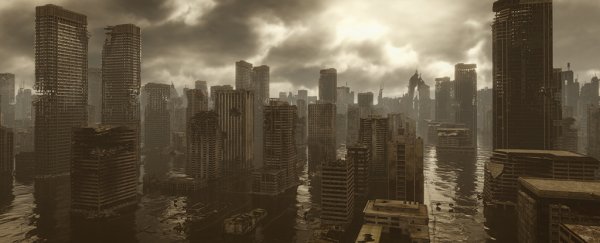Speculating over humanity's demise is a sport we humans have enjoyed since forever. We build religions on our eschatological hopes, weave fiction out of our dystopian fears, and even write songs about the end of the world as we know it.
So it's surprising that in the midst of an escalating global climate crisis, one that impacts everything from the health of individuals to the sustainability of entire ecosystems and their resources, potential global catastrophes are so underexplored.
A report published recently in the Proceedings of the National Academy of Sciences argues it's high time we start taking worst-case scenarios seriously and come up with a solid game plan on what happens if – or indeed, when – our current way of life collapses.
" Climate change has played a role in every mass extinction event. It has helped fell empires and shaped history. Even the modern world seems adapted to a particular climate niche," says the report's lead author Luke Kemp, a researcher with the University of Cambridge's Centre for the Study of Existential Risk in the UK.
"Paths to disaster are not limited to the direct impacts of high temperatures, such as extreme weather events. Knock-on effects such as financial crises, conflict, and new disease outbreaks could trigger other calamities, and impede recovery from potential disasters such as nuclear war."
The old apocalyptic cavalry of pestilence, war, and famine should include a new partner, according to the essay's authors: extreme weather.
Recent history has already given humanity a sneak preview of what pandemics, economic instability, and global food shortages might look like as they combine. While the results aren't pretty, the structures of global civilization remain relatively intact.
At some point, however, those structures that allow us to weather such storms will collapse.
Successive pandemics as food shortages drive humans into closer contact with zoonotic disease reservoirs; famines on top of wars that limit food distribution for years, then decades in a row; run-away inflation as economies struggle to cope with new ways of doing business in a hotter, disaster-ravaged world.
"Average annual temperatures of 29 degrees currently affect around 30 million people in the Sahara and Gulf Coast," says Chi Xu, a researcher in social complexity at Nanjing University.
"By 2070, these temperatures and the social and political consequences will directly affect two nuclear powers, and seven maximum containment laboratories housing the most dangerous pathogens. There is serious potential for disastrous knock-on effects."
The problem isn't so much that we can't imagine such outcomes. The warnings aren't new.
As described by the director of the Potsdam Institute for Climate Impact Research, Johan Rockström, "We increasingly understand that our planet is a more sophisticated and fragile organism. We must do the math of disaster in order to avoid it."
Which, the scientists argue, is the problem. Good risk management involves not just predicting which scenarios are likely but guarding against those which would have the direst impact.
Optimistically, we might turn things around and push that rise back a little longer. The perfect combination of behavior change, policy action, and innovation might even help plateau temperature rises to levels that won't bombard us with a new catastrophe every six months.
If things continue as they do now – which the Intergovernmental Panel on Climate Change (IPCC) has high confidence it will – we can almost certainly expect to be on average 1.5 degrees warmer sometime between 2030 and 2052, compared with pre-industrial levels.
There is a roughly one in five chance, though, that an atmosphere of around 560 parts per million (ppm) of carbon dioxide in the atmosphere temperatures will be several degrees warmer still. As of May this year, we hit 420 ppm. With rates steadily rising by a few parts per million every year or so, it's a gamble some of our children might need to contend with.
According to a study on IPCC assessments published by Kemp and colleagues earlier this year, the intergovernmental body's research focus doesn't deal enough with such doomsday outliers.
Taken in context with previous research indicating we're woefully ill-informed on exactly what warming well beyond 2 degrees Celsius looks like, we could be missing a golden opportunity to be better informed should more optimistic plans fail.
"Facing a future of accelerating climate change while remaining blind to worst-case scenarios is naive risk-management at best and fatally foolish at worst," says Kemp.
This Perspectives piece was published in PNAS.
